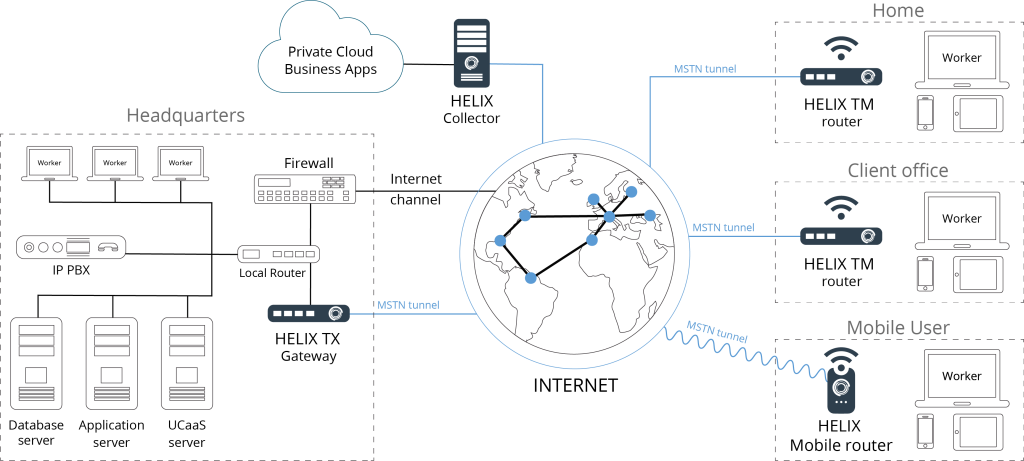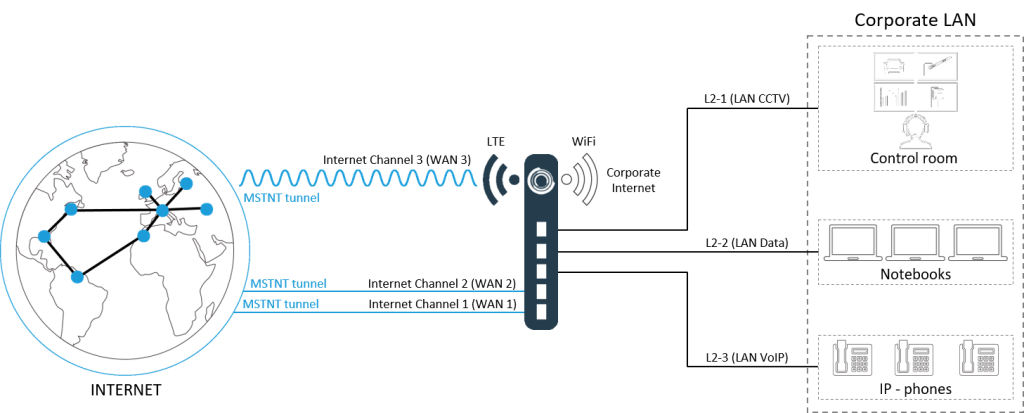HeliX World, an international operator of corporate communications headquartered in Europe and providing services for organization and construction of corporate networks of any scale throughout the world.
The HeliX network platform developed using a new network technology – Multi Service Tunnel Network Technology (MSTNT) – provides a comprehensive solution for organizing and connecting the Subscriber to the global world network and services for the Subscriber’s business needs in order to obtain the Subscriber a secure corporate private network (HELIX Autonomous System), which enables rational use of network resources, maximum utilization of allocated bandwidth and optimizes costs of the entire network infrastructure operation.
The Autonomous System HeliX (AS) allows transferring the entire infrastructure of a user’s network to cloud service resources.

HeliX platform is based on Multi-Platform Tunnel OS (MPT OS), which is installed on any modern telecommunications equipment, implemented on processors with X86, ARM, MIPS architecture.
The AS is built on the second level of OSI-Ethernet and runs on the router operating system kernel, which completely eliminates the use of IP-addresses. Instead, the AC uses its own mechanism for assigning network indices, which is virtually inaccessible to DDoS and other IP-based network attacks.
By creating a monolithic channel between all networked business resources, the AS eliminates the possibility of hacker attacks and provides a new level of security quality.
The AS enables you to use network resources efficiently and securely and provides connectivity between the cloud, offices and users, keeping you connected at work, at home and on the go, ensuring your confidential data can be accessed securely from anywhere in the world.
The AC has all the necessary tools to manage and monitor, diagnose and control all the processes occurring in the network.
Each subscriber terminal, depending on the number of physical ports and device capacity, can simultaneously handle several (up to 255 physical channels) independent WAN Internet and/or Intranet channels in summation, redundancy (hot and cold) mode while transmitting six independent L2 channels, with MTU up to 2048, and dynamic QoS.
Also, each L2 channel can be prioritized over the other channel.
Each LAN port of a subscriber terminal can be configured as:
- L2 channel – capable of transmitting packets with or without 802.1Q VLAN technology (single TAG, QinQ),
- L3 channel – with full routing functionality of IP networks.


The customer’s wishes regarding customization of subscriber terminals according to the customer’s needs (increasing the number of configurable L2 and L3 ports, the number of independent L2 channels, etc.), as well as adaptation of telecommunication equipment used by the customer to the HeliX platform are also taken into account when designing the AS.
Implementation of the HeliX Platform requires no changes to the existing infrastructure and facilitates a rapid transition to a financially more profitable solution without service disruption or interruption.
The application of the HeliX Platform will provide:
- Full channel summation (adding the bandwidth of different channels into a monolithic data channel).
- Packet sequence recovery.
- Built-in protection against loops in the L2 segment.
- Loss reduction and jitter equalization mechanisms.
- Building L2 tunnels over 3G, 4G (LTE) and 5G channels.
- Mechanism for protecting the network from DDOS attacks.
- Increasing bandwidth utilization efficiency of the core network.
- Increased bandwidth through monolithic streams.
- Improved channel quality and service connectivity.
- Ability to tune the network to the required performance.
- Reducing network congestion.
- Reduced staff workload.
- Reducing the cost of maintaining and servicing the network.
- Expanded range of services.
- Tools for control and monitoring of all processes taking place in the network.
- Centralized control and management of all network resources in real time.
- Ability to quickly localize network problems.
- High reliability, manageability and fault tolerance of the network.
- Quick optimization and network modernization.
- Provide subscribers with easy connection to the network from anywhere in the world.


